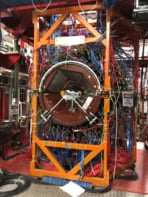
The weak charge of the proton has been measure to high-precision for the first time. The work was done at the Thomas Jefferson National Accelerator Facility (Jefferson Lab) in Virginia and the result is in excellent agreement with the Standard Model of particle physics. The team that made the measurement hopes that further, related experiments will provide even more insight into physics beyond the Standard Model.
Done by the international QWEAK collaboration, the experiment involved scattering a beam of spin-polarized electrons from stationary protons in a liquid hydrogen target. The scattering process is dominated by the electromagnetic interaction, but a tiny contribution comes from the weak nuclear force. By measuring the weak contribution, the team can calculate the weak charge of the proton. The weak charge quantifies how a particle couples to the Z0 boson via the weak interaction. It has been measured at high-precision for the electron, but not the proton – until now.
Helping handedness
The measurement process got a helping hand from a quirky property of the weak interaction. The probability of a particle being scattered by the electromagnetic interaction is unaffected by the direction of its spin angular momentum. Remarkably, however, this is not true for weak nuclear scattering. A particle whose spin angular momentum vector points in the same direction as its velocity is scattered differently than a particle with its spin pointing in the opposite direction. This is both a deep, puzzling asymmetry in the fundamental laws of physics and a convenient experimental fingerprint of scattering through the weak interaction.
Team member Gregory Smith of Jefferson Lab says that making the proton measurement presents both significant challenges and tantalizing opportunities: “The nice feature about the weak charge of the proton is that it’s predicted in the Standard Model to be almost zero,” he explains, “so the effects of any new physics that might show up on top of that small background will show up more easily.” The tiny value of the scattering asymmetry, however, makes it very difficult to measure. Furthermore, scattering asymmetry comes not just from the weak interaction but also from the internal structure of the proton.
The asymmetry caused by proton structure increases with the square of momentum transfer, so the researchers kept the beam energy low. They carried out two six-month experimental runs, making improvements to their experimental apparatus in the gap between runs. They then compared their results with other experiments done with higher-energy beams. This allowed them to estimate how the asymmetry changed with energy, and therefore what it would have been if no energy had been exchanged between the particles – impossible as it would have required zero-energy scattering. Their calculated value was about 226 parts per billion.
Constraining leptoquarks
This allowed the team to calculate the proportion of scattering from the weak interaction, and therefore the weak charge of the proton. Their results are in almost perfect agreement with the Standard Model prediction, and put new constraints on the possible existence of leptoquarks. These are hypothetical particles in some extensions of the Standard Model that have quantum numbers of both quarks and leptons.

Experiment probes strength of the weak interaction
Xiaochao Zheng of the University of Virginia, who was not involved in the research, believes the finding is significant. “As time goes on, these kinds of high-precision measurements will be done with increasingly higher precision, such as the planned Moller and the PVDIS experiments using the upgraded accelerator at Jefferson Lab.” she says.
Researchers at the University of Mainz in Germany are currently planning an even more accurate determination of the weak charge of the proton, and some QWEAK members are part of that team.Jefferson Lab, meanwhile, is planning to measure the weak charge electron to a new and record-breaking precision. This he says, will lead to an even more stringent test of the Standard Model.
The findings are reported in Nature.



